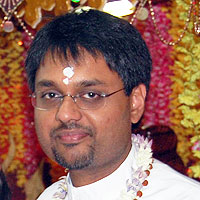From a satsang with Pt. Dr. Umesh Persad at Shiva Shakti Mandir of Marion Oaks, Florida
In human’s eternal pursuit of happiness, we find ourselves entangled in a web of emotions, as we seek joyous outcomes and a sense of wellbeing. Yet, as we delve further into the depths of joy, a profound question arises: What is happiness really?
As often understood, it is often a fleeting state — an emotion triggered by favourable circumstances or joyous events. However, the ephemeral nature of being happy leads us to ponder its transience. Can anyone truly claim to be in a perpetual state of joy? The answer unravels when we examine its counterpart: sadness and, at times, even depression.
The external nature of joy becomes evident when we explore the reasons behind our emotional states. Being happy is a response to something good happening externally, while unhappiness often arises when circumstances fail to align with our expectations. The duality of the world, characterised by ups and downs, happiness and sadness, challenges our attempts to control and dictate the course of life.
Acceptance emerges as a key theme in understanding and transcending the difference between joy and sorrow. Despite our best efforts, the world does not always conform to our desires, and people do not always behave as we wish. True happiness, as scriptures suggest, is found in recognizing that the natural state of our being is one of peace.
Imagine a serene pond disturbed by a thrown object, creating ripples of happiness or sadness. Yet, with the passage of time, the pond returns to its calm state. Similarly, the pursuit of joy in the external world often leads to a perpetual state of sadness. The revelation dawns when we cease our relentless search and embrace the inherent peace within.
The key practice, then, becomes acceptance — acceptance that we may not have complete control over external events, but we do have control over our own reactions. The world, with its unpredictable twists and turns, cannot be relied upon to be a constant source of joy. Family, friends and colleagues, like ourselves, who are sources of our emotions, also have to navigate the same unpredictable journey.
To unlock the door to lasting joy, we must turn inward and master the only aspect truly within our control — the mind. The pursuit of happiness and peace finds its anchor in contemplation, prayer and meditation. Contemplation invites us to reflect deeply on life’s nuances. Prayer becomes an act of surrender to a divine power, embracing acceptance. Meditation, the profound practice of letting go, takes us beyond the confines of the mind, revealing a space where true contentment resides.
In conclusion, the quest for true joy transcends the external ebb and flow of emotions. It is an internal journey of acceptance, contemplation, prayer and meditation — a journey that leads to the serenity of the soul and the enduring peace that lies within.



